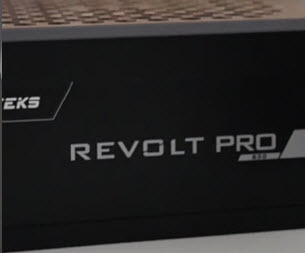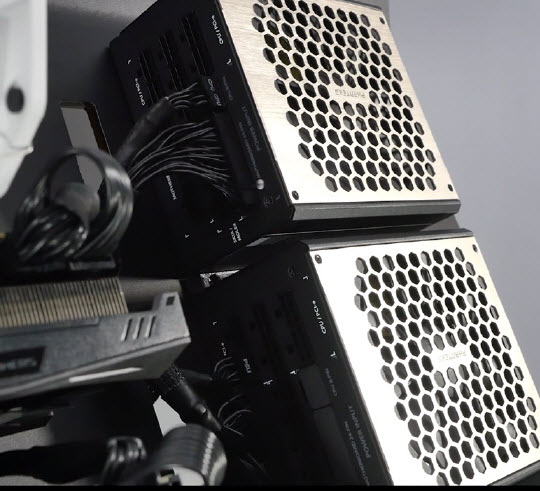Phanteks Enters The PSU Market
LAS VEGAS, NV -- Phanteks has wanted to enter the PSU market for quite some time now, and it finally did, using three Seasonic high-end platforms that appear to belong to the Prime lines. The two Phanteks PSU lines are the Revolt X and Revolt Pro.
For the moment, the first consists of only one model with 1200W capacity (the PH-P1200PS), and the second lists two models (PH-P1000GC and PH-P850GC), which have 1000W and 850W capacities, respectively. All units are fully modular. The PH-P1200PS sports 80 PLUS Platinum efficiency, whereas the other two are 80 PLUS Gold certified. So far they aren't certified by Cybenetics, so we don't have a detailed performance report or any information about their noise output.
The interesting feature of the PH-P1200PS is that it can power two systems at once, meaning that it has all necessary cables for two mainboards: a couple of 24-pin ATX cables and three 8-pin EPS connectors. On top of that, the PSU comes with eight 6+2 pin PCIe connectors, so it also supports quite a large number of graphics cards. The PSU switches on when either of the two ATX connectors are triggered and turns off when neither of them draws any power. Therefore, you can independently power two systems at once (although they would obviously need to be in the same chassis).
As we already mentioned, the Revolt Pro line consists of two units. The key feature of those units is that they combined offer double the power. Thus, you can either buy those PSUs in pairs or just get one and use your old PSU along with it. On the modular board of the Revolt Pro units, there are two "input" connectors for the 24-pin ATX and 8-pin EPS connectors of the second PSU, which will operate in parallel. Those input cables are used only for synchronizing the PSUs.
We saw a similar scheme some years ago in a couple of Jou Jye units, which were also made by Seasonic, with the only difference being that those units used just a single cable (see photo below) for synchronizing their power states. In any case, it isn't ideal to use two PSUs in parallel, because the efficiency is crippled (especially at light loads) because of the combined energy losses. Under mid and high loads things are better, but if you want lots of power, it's far better to use a single and powerful PSU, rather than combining two smaller ones.
The PH-P1200PS will cost $260, so it will be quite expensive, whereas the PH-P1000GC and the PH-P850GC will cost $160 and $130, respectively.



Get Tom's Hardware's best news and in-depth reviews, straight to your inbox.

Aris Mpitziopoulos is a contributing editor at Tom's Hardware, covering PSUs.
-
TJ Hooker Reply
Referring to the PH-P1200PS which has two motherboard power connectors? 1200W isn't really enough to power two mining rigs, as a typical mining rig has 6+ GPUs. Depending on which GPUs it has and what it's mining, it may require a 1200W supply just for 1 rig.20583670 said:sounds like an awesome way to power multiple cryptominers -
shrapnel_indie If Phanteks wants more sales in PSUs, they'll need to get some lower power units into their lineup, especially when not everyone wants over 1000W of PSU.Reply -
mihen Personally, I don't see the point in entering the PSU market when all your doing is rebadging someone else's PSU. Makes shopping for a good PSU difficult as you sort through the hundreds of available lines to see what one of 4 manufacturers produced it and picking one from the 2 who do a good job.Reply -
Darkbreeze Reply20586345 said:Personally, I don't see the point in entering the PSU market when all your doing is rebadging someone else's PSU. Makes shopping for a good PSU difficult as you sort through the hundreds of available lines to see what one of 4 manufacturers produced it and picking one from the 2 who do a good job.
This has been the case for practically EVERY PSU brand since the beginning of consumer platforms. Nearly every PSU that is not branded as a Seasonic, Super Flower, FSP, Flextronics, Enermax (Not anymore though since they closed down their own facilities and farm out their own designs to be built elsewhere) or HEC, IS a rebranded power supply based either on somebody else's platform or built by somebody else based on a platform of their own design.
This is how it has always been, and how it will always be. It is nothing new and if nobody did this then pretty much the only power supplies we'd see on the market would be low quality units or those sold by the six names I listed above plus maybe at that point CWT might have to enter the market with their own brand of power supplies since they basically only exist to supply Corsair and others with designs to be re-branded.
Let's also not forget Delta, who partners with nearly every OEM PC manufacturer that Seasonic doesn't, and some that they do, but who also provides a good number of platforms for a wide variety of well known brand names as well.

